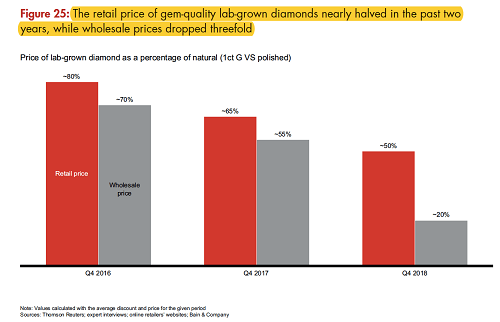
The Best Designer Jewelry and Engagement Ring Brands
June 24, 2020
A Complete Guide to Flower Engagement Rings
July 29, 2020Are Lab Grown Diamonds Worth Anything?

Image Courtesy Brilliant Earth
Lab grown diamonds (also referred to as synthetic diamonds or laboratory created diamonds) continue to be a matter of confusion and intrigue for the modern diamond buyer. With questions arising about the value, appearance and ethical claims of lab grown diamonds, buyers must be in possession of all the facts before making their decision.
I must state that although I am a diamond expert and enthusiast, my goal is not to sway people towards diamonds. There are many benefits to choosing a natural diamond for your engagement ring, but I have been equally enthralled with sapphire solitaires, ruby necklaces and pearl earrings. My intention is to ensure that if you are looking for a diamond, you make a financially and emotionally smart purchase that will bring you joy for years to come.
With that in mind, let’s take a look at lab growndiamonds and see if they are a reasonable substitute for naturals.
What is a Lab Grown Diamond?
A synthetic diamond is a man-made diamond that possesses the same appearance and qualities as a natural diamond. There are two processes for creating a lab grown diamond; High Pressure High Temperature (HPHT) and Chemical Vapour Deposition (CVD).
In each case, the total time to create a synthetic diamond can be anywhere from two weeks to two months – a little different to the millions of years it takes a natural diamond to form.
Lab grown diamonds are not the same as imitation diamonds (though terminology in this area is a little grey). Moissanite, cubic zirconia and white sapphires are sometimes used as alternatives to diamonds – these materials have different properties to a natural diamond (appearance, hardness, lustre, fire, brilliance etc). A lab grown diamond completely mirrors a natural diamond in all of these areas.
Why Are Lab Grown Diamonds Cheap?
I am asked this question a lot by buyers looking to maximise budget, and it is a fair question. If lab grown diamonds look and behave the same way as natural diamonds, what is the difference except for the price?
If we compare this (natural) 1.05ct G-VS2 True Hearts™ by James Allen for $7,000 to this (lab created) 1.04 G-VS2 Ideal cut for $1,890 it will give you an idea of the vast price differences between lab grown and natural diamonds.
Being less expensive than a natural diamond does not indicate that lab grown diamonds are cheap. In fact, the resale value of lab-grown diamonds is so low and the market is so heavily saturated that this price can actually be considered high.
The real question you should be asking is why are lab grown diamonds so expensive as they can mass manufactured by the millions?
The Price of Lab Grown Diamonds
It cannot be assumed that all lab grown/synthetic diamonds are cheaper than their natural equivalent. In fact, only a few years ago, many vendors were pricing lab grown diamonds up to 25% more expensive than naturals. Just three years on and the price of lab-grown diamonds has dropped dramatically. As more competitors entered the lab grown diamond market, the value plummeted while the price of natural diamonds increased.

Image Courtesy BDI
History has shown us that fluctuations in the diamond market happen, but the price of lab grown diamonds is only heading in one direction – and fast.
Are Lab Grown Diamonds More Ethical?
Setting aside price, a huge part of the marketing of synthetic created diamonds is centred around them being a more ethical and eco-friendly choice for modern consumers; a highly commendable feature, but is it true?
The natural diamond market is haunted by its dark past. Whilst significant historically, modern practices and the introduction of the Kimberley Process have successfully eliminated conflict diamonds from the open market. Furthermore, the best vendors are explicit in their commitment to social responsibility and the steps they’ve taken to give back to the communities surrounding mining areas. Whiteflash are a fantastic example of this and make their position clear in their social responsibility pages.
That is not to say synthetic diamonds can’t be ethical and eco friendly, in fact there are wonderful sellers of lab grown diamonds who are fully dedicated to this initiative – however, there are others who simply use it as a clever marketing ploy to further tarnish the reputation of natural diamonds. For both natural and lab grown diamonds, look for tangible evidence of a socially conscious company and proven eco benefits.
I Don’t Plan to Sell My Diamond
You won’t make back every penny re-selling a natural diamond (unless it is something extremely unusual) but you will make back a hefty percentage. By contrast, a second-hand lab created diamond bought for $2,000 will re-sell for around $100.
It is easy to believe you will not wish to sell your diamond; after all, by their nature they should last a lifetime. However, in my experience, changes in your financial position (good and bad) might mean you will to sell your diamond, or indeed trade it up for a better one! I have helped countless people in both of these positions and so often when they purchased the diamond, they had no intentions of selling/trading up.
Should I Buy a Lab Grown Diamond?
If I did not have the most generous budget, I would suggest looking into lab-created diamonds and/or using the money you save on the diamond to explore designer settings as an alternative.




